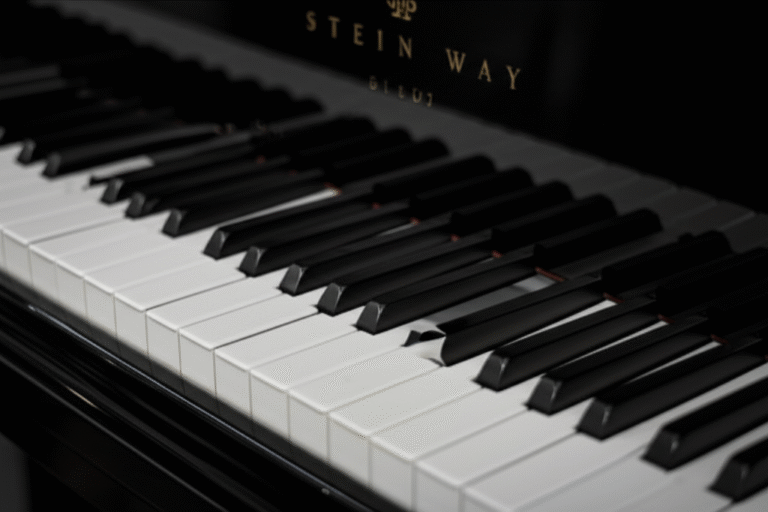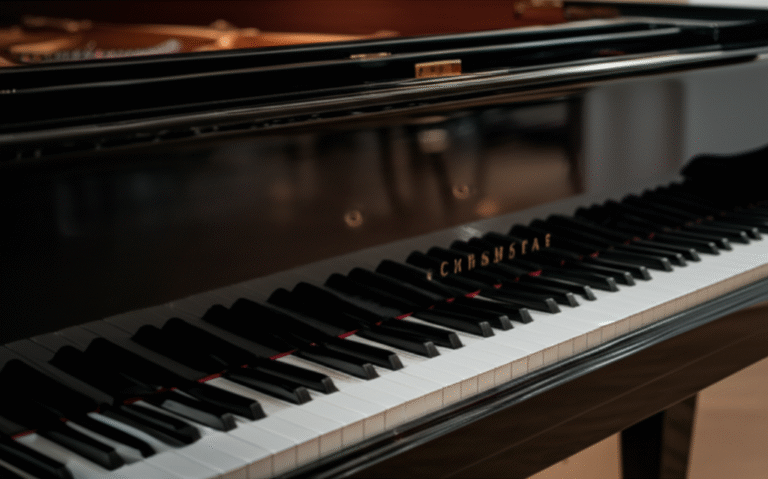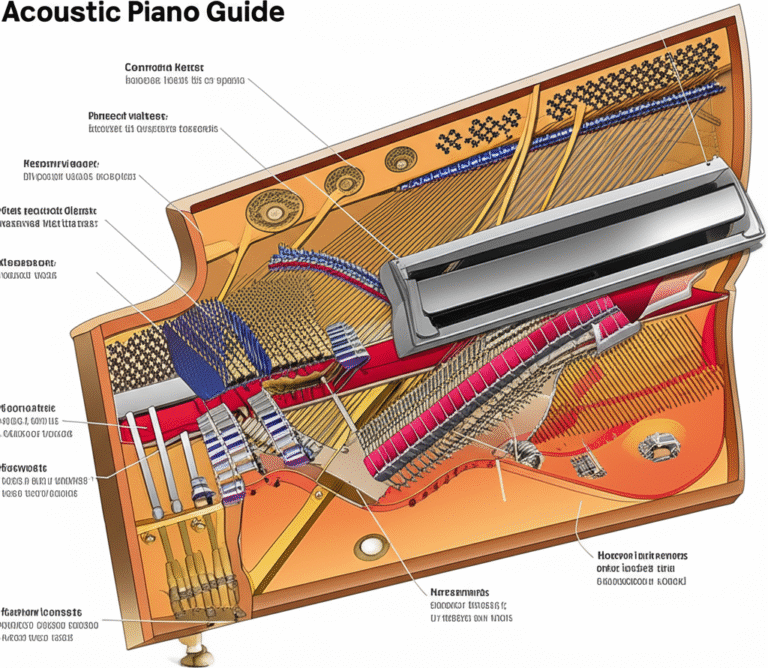Support our educational content for free when you buy through links on our site. Learn more
How to Choose a Piano to Buy: 15 Expert Tips for 2025 🎹
Imagine walking into a room filled with pianos — grand, upright, digital, and hybrid — each whispering promises of melodies yet to be played. Choosing the perfect piano can feel like navigating a musical maze. But fear not! Whether you’re a beginner dreaming of your first keyboard or a seasoned player ready to upgrade, this guide will unravel the mystery behind selecting the ideal piano for your unique journey.
Did you know that the piano has evolved over 300 years, from Bartolomeo Cristofori’s first pianoforte to today’s cutting-edge digital marvels? 🎶 In this comprehensive guide, we’ll explore everything from acoustic vs. digital pianos, space considerations, budget tips, to the hidden costs of ownership. Plus, we’ll share insider secrets from the musicians at Piano Brands™ to help you confidently pick the piano that’ll inspire you for years to come.
Key Takeaways
- Define your musical goals and space before choosing between acoustic, digital, or hybrid pianos.
- Acoustic pianos offer unmatched authentic sound and touch but require maintenance and space.
- Digital pianos provide versatility, portability, and modern features ideal for beginners and apartment living.
- Test-drive multiple pianos to find the feel and sound that resonate with you.
- Consider hidden costs like tuning, moving, and accessories when budgeting.
- Explore reputable brands like Yamaha, Steinway, Roland, and Kawai for quality and reliability.
Ready to start your piano journey? Check out our curated selections:
- 👉 Shop Acoustic Pianos: Yamaha | Steinway & Sons | Kawai
- 👉 Shop Digital Pianos: Roland | Casio | Korg
Table of Contents
- ⚡️ Quick Tips and Facts
- The Grand Symphony of Choice: A Brief History of Piano Evolution 🎹
- Why Are You Buying a Piano? Defining Your Musical Journey 🎶
- Budgeting for Your Musical Masterpiece: What to Expect 💰
- Space, Sound, and Neighbors: Assessing Your Environment 🏡
- Acoustic vs. Digital: The Age-Old Debate Settled (for YOU!) 🤔
- Beyond the Keys: Essential Piano Accessories You’ll Need 🎁
- The Hunt is On! Where to Buy Your Dream Piano 🎯
- Test Drive Your Future: The Importance of Playing Before You Pay 🎹
- Asking the Right Questions: Your Piano Buying Checklist 📝
- The “Hidden” Costs of Piano Ownership: Beyond the Sticker Price 💸
- Renting vs. Buying: A Stepping Stone or a Permanent Home? ➡️⬅️
- When to Upgrade: Growing with Your Instrument 🌱
- Quick Tips for Maintaining Your Piano’s Health & Happiness 🧼
- Conclusion: Your Perfect Piano Awaits! 🎉
- Recommended Links 🔗
- FAQ: Your Burning Piano Questions Answered! 🔥
- Reference Links 📚
⚡️ Quick Tips and Facts
Choosing the right piano is a journey, not a race! 🏃♀️ Take your time, explore your options, and don’t be afraid to ask questions. We’re here to guide you every step of the way.
Here are some quick tips to get you started:
- Know your budget: Pianos come in a wide range of prices, from affordable digital models to high-end acoustic grand pianos. Set a realistic budget before you start shopping.
- Consider your space: Acoustic pianos can be quite large, so make sure you have enough room. Digital pianos are more compact and offer greater flexibility.
- Think about your playing style: Are you a beginner, an intermediate player, or a seasoned professional? Different pianos cater to different skill levels.
- Don’t be afraid to try before you buy: Visit a piano store and play a few different models to see what feels best for you.
- Read reviews: Check out online reviews from other piano buyers to get a sense of the pros and cons of different models.
Did you know? The piano was invented in the 18th century by Bartolomeo Cristofori, an Italian harpsichord maker. 🎹 It’s been a beloved instrument ever since, and it continues to inspire musicians of all ages and abilities.
Ready to dive deeper? Let’s explore the history of the piano and how it’s evolved over the years.
The Grand Symphony of Choice: A Brief History of Piano Evolution 🎹
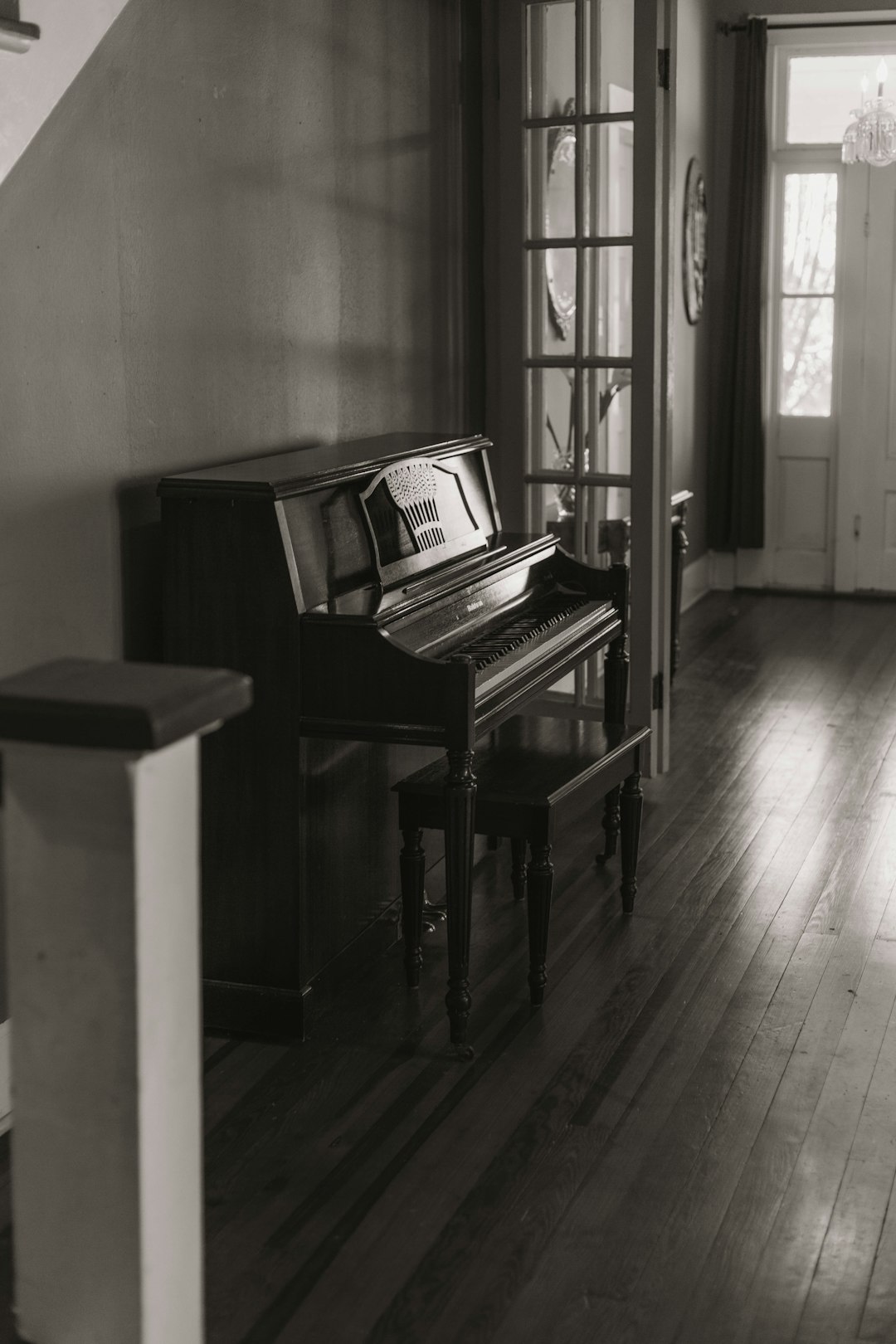
The piano has a rich and fascinating history, evolving from its humble beginnings to the sophisticated instruments we know and love today.
Here’s a quick timeline of key milestones:
- 1700s: Bartolomeo Cristofori invents the pianoforte, a forerunner of the modern piano, in Italy. The name “pianoforte” reflects the instrument’s ability to produce both soft (piano) and loud (forte) sounds.
- 1700s-1800s: The piano gains popularity throughout Europe, with notable makers like Johann Sebastian Bach and Ludwig van Beethoven composing for the instrument.
- 1800s: The modern piano is developed, featuring a larger soundboard, a more complex action, and a more robust frame.
- 1900s: The digital piano emerges, offering a more affordable and portable alternative to the acoustic piano. Digital pianos use electronic technology to create sound, and they often feature a wide range of sounds and features.
- 2000s-Present: The piano continues to evolve, with advancements in digital technology leading to more realistic and expressive digital pianos. Hybrid pianos, which combine the best of both acoustic and digital worlds, are also gaining popularity.
Want to learn more about the fascinating history of the piano? Check out our dedicated section on Piano History.
Why Are You Buying a Piano? Defining Your Musical Journey 🎶
Before you start shopping for a piano, it’s important to ask yourself why you’re buying one. What are your musical goals? What kind of music do you want to play? What level of player are you?
Here are some common reasons people buy pianos:
- To learn to play: If you’re a beginner, you might be looking for a piano that’s easy to learn on and affordable.
- To improve your skills: If you’re an intermediate or advanced player, you might be looking for a piano that offers a more challenging and rewarding playing experience.
- To perform: If you plan to perform, you’ll need a piano that can project sound well and has a rich, full tone.
- For enjoyment: Some people simply enjoy playing the piano for pleasure, and they might choose a piano that fits their personal style and preferences.
Once you know why you’re buying a piano, you can start narrowing down your choices.
Budgeting for Your Musical Masterpiece: What to Expect 💰
Let’s talk money! Pianos can range in price from a few hundred dollars for a basic digital model to tens of thousands of dollars for a high-end acoustic grand piano.
Here’s a general idea of what you can expect to pay for different types of pianos:
- Digital Pianos: Digital pianos are generally more affordable than acoustic pianos. You can find basic models for under $500, while more advanced models can cost upwards of $2,000.
- Acoustic Pianos: Acoustic pianos are more expensive than digital pianos, but they offer a more traditional and authentic playing experience. Upright pianos typically cost between $3,000 and $10,000, while grand pianos can cost upwards of $20,000.
Remember, the price of a piano is just one factor to consider. You’ll also need to factor in the cost of accessories, such as a piano bench, a music stand, and a tuning.
Ready to explore some specific piano models and their price ranges? Let’s move on to the next section!
Space, Sound, and Neighbors: Assessing Your Environment 🏡
Where will your piano live? This is a crucial question to answer before you start shopping.
Here are some factors to consider:
- Space: Acoustic pianos can be quite large, so make sure you have enough room for one. Measure the space where you plan to put the piano, and consider the height, width, and depth of different models.
- Sound: Acoustic pianos produce a lot of sound, so you’ll need to consider how this will affect your neighbors. If you live in an apartment or a house with thin walls, you might want to choose a digital piano with headphone capabilities.
- Humidity and Temperature: Acoustic pianos are sensitive to changes in humidity and temperature. If you live in a climate with extreme fluctuations, you’ll need to take extra care to protect your piano.
Think about your environment and how it will impact your piano choice.
Acoustic vs. Digital: The Age-Old Debate Settled (for YOU!) 🤔
The choice between an acoustic and a digital piano is a personal one. There’s no right or wrong answer, and the best choice for you will depend on your individual needs and preferences.
Let’s break down the pros and cons of each type:
Acoustic Pianos: The Soulful Resonance ✨
Acoustic pianos are known for their rich, complex sound and their traditional feel. They’re the instrument of choice for many classical pianists, and they offer a truly immersive playing experience.
Here are some of the key benefits of acoustic pianos:
- Authentic sound: Acoustic pianos produce a natural, organic sound that’s unmatched by digital pianos.
- Responsive touch: The keys on an acoustic piano are weighted, which allows you to control the volume and dynamics of your playing.
- Long lifespan: Acoustic pianos are built to last, and they can be enjoyed for generations.
However, acoustic pianos also have some drawbacks:
- Expensive: Acoustic pianos are significantly more expensive than digital pianos.
- Large and heavy: Acoustic pianos require a lot of space and can be difficult to move.
- Require maintenance: Acoustic pianos need to be tuned regularly, and they can be susceptible to damage from humidity and temperature changes.
Let’s explore the different types of acoustic pianos in more detail:
1. Grand Pianos: The King of Instruments 👑
Grand pianos are the largest and most prestigious type of acoustic piano. They have a horizontal soundboard, which allows for a larger and more resonant sound. Grand pianos are often found in concert halls and professional studios, but they can also be enjoyed in the home.
Here are some of the key features of grand pianos:
- Superior sound quality: Grand pianos produce a rich, full sound with a wide dynamic range.
- Responsive action: The keys on a grand piano are more responsive and sensitive than those on an upright piano.
- Elegant design: Grand pianos are often considered to be works of art, and they can add a touch of elegance to any room.
However, grand pianos are also the most expensive type of piano. They require a lot of space, and they can be difficult to move.
2. Upright Pianos: Vertical Virtuosity 🎼
Upright pianos are a more compact and affordable option than grand pianos. They have a vertical soundboard, which makes them more space-efficient. Upright pianos are a popular choice for home use, and they’re often used in schools and music studios.
Here are some of the key features of upright pianos:
- Compact size: Upright pianos are smaller than grand pianos, making them a good choice for smaller spaces.
- Affordable price: Upright pianos are generally more affordable than grand pianos.
- Durable construction: Upright pianos are built to withstand the rigors of everyday use.
However, upright pianos don’t have the same sound quality or responsiveness as grand pianos. They can also be more difficult to play, especially for beginners.
What to Look for in an Acoustic Piano: A Deep Dive 🔍
When shopping for an acoustic piano, there are a few key things to look for:
- Sound: Listen to the piano being played, and pay attention to the tone, the volume, and the clarity of the sound.
- Action: The action is the mechanism that connects the keys to the hammers. A good action should be responsive and smooth.
- Keys: The keys should be smooth and free of damage. They should also have a comfortable feel.
- Construction: The piano should be well-constructed and free of any defects.
- Brand: Choose a reputable piano manufacturer with a good track record. Check out our guide to the 12 Most Popular Acoustic Piano Manufacturers to Know in 2025 🎹.
The Commitment: Maintenance & Care for Your Acoustic Gem 💎
Acoustic pianos require regular maintenance to keep them in good condition. This includes tuning, cleaning, and occasional repairs.
Here are some tips for maintaining your acoustic piano:
- Tune it regularly: Acoustic pianos should be tuned at least once a year, and more often if they’re played frequently.
- Clean it regularly: Dust and dirt can accumulate on the keys, the soundboard, and the strings. Use a soft cloth to clean the piano regularly.
- Protect it from humidity and temperature changes: Acoustic pianos are sensitive to changes in humidity and temperature. Keep your piano in a stable environment to prevent damage.
Acoustic pianos are a significant investment, but they can provide a lifetime of enjoyment. With proper care and maintenance, your acoustic piano will continue to sound beautiful for years to come.
Digital Pianos: The Modern Marvel 💡
Digital pianos offer a more affordable and versatile alternative to acoustic pianos. They use electronic technology to create sound, and they often feature a wide range of sounds and features.
Here are some of the key benefits of digital pianos:
- Affordable: Digital pianos are generally more affordable than acoustic pianos.
- Compact and portable: Digital pianos are smaller and lighter than acoustic pianos, making them easier to move.
- Versatile: Digital pianos often feature a variety of sounds, including piano, electric piano, organ, and synthesizer sounds.
- Features: Digital pianos often come with built-in features, such as a metronome, a recorder, and headphone capabilities.
However, digital pianos also have some drawbacks:
- Not as authentic: Digital pianos don’t have the same natural sound as acoustic pianos.
- Limited touch response: The keys on a digital piano aren’t as responsive as those on an acoustic piano.
- Require power: Digital pianos need to be plugged in to work.
Let’s explore the different types of digital pianos in more detail:
1. Console Digital Pianos: Home Sweet Home 🛋️
Console digital pianos are designed to look and feel like acoustic pianos. They often have a sleek, modern design and a full-sized keyboard. Console digital pianos are a popular choice for home use, and they offer a more immersive playing experience than portable digital pianos.
Here are some of the key features of console digital pianos:
- Realistic sound: Console digital pianos often feature high-quality sound samples that closely mimic the sound of an acoustic piano.
- Weighted keys: The keys on a console digital piano are often weighted to provide a more realistic playing experience.
- Built-in speakers: Console digital pianos typically have built-in speakers that provide a good sound quality.
However, console digital pianos can be more expensive than portable digital pianos. They also require more space.
2. Portable Digital Pianos: Gig-Ready & Go-Anywhere 🚀
Portable digital pianos are designed to be compact and lightweight. They’re perfect for musicians who need to take their piano on the go. Portable digital pianos often have a smaller keyboard and fewer features than console digital pianos, but they’re still a great option for practice and performance.
Here are some of the key features of portable digital pianos:
- Compact size: Portable digital pianos are small enough to fit in a backpack or a carrying case.
- Lightweight: Portable digital pianos are lightweight, making them easy to transport.
- Affordable: Portable digital pianos are generally more affordable than console digital pianos.
However, portable digital pianos often have a less realistic sound and feel than console digital pianos. They also may have fewer features.
3. Hybrid Pianos: Blending the Best of Both Worlds 🤝
Hybrid pianos combine the best of both acoustic and digital pianos. They feature a real acoustic piano action, but they use digital technology to create sound. Hybrid pianos offer a more authentic playing experience than digital pianos, but they’re still more affordable and versatile than acoustic pianos.
Here are some of the key features of hybrid pianos:
- Realistic sound: Hybrid pianos use digital technology to create a realistic and expressive sound.
- Responsive action: Hybrid pianos feature a real acoustic piano action, which provides a more responsive and natural playing experience.
- Versatility: Hybrid pianos often feature a variety of sounds and features, such as a metronome, a recorder, and headphone capabilities.
However, hybrid pianos are generally more expensive than digital pianos. They also require more space than portable digital pianos.
What to Look for in a Digital Piano: Your Tech Checklist ✅
When shopping for a digital piano, there are a few key things to look for:
- Sound: Listen to the piano being played, and pay attention to the tone, the volume, and the clarity of the sound.
- Action: The action is the mechanism that connects the keys to the sound engine. A good action should be responsive and smooth.
- Keys: The keys should be smooth and free of damage. They should also have a comfortable feel.
- Polyphony: Polyphony refers to the number of notes that can be played simultaneously. A higher polyphony number means that the piano can play more complex chords and melodies without dropping notes.
- Features: Digital pianos often come with a variety of features, such as a metronome, a recorder, and headphone capabilities. Choose a piano with the features that are most important to you.
- Brand: Choose a reputable piano manufacturer with a good track record.
The Digital Advantage: Versatility & Convenience Unlocked 🎧
Digital pianos offer a level of versatility and convenience that acoustic pianos simply can’t match.
Here are some of the key advantages of digital pianos:
- Headphone capabilities: Digital pianos allow you to practice silently with headphones, which is perfect for apartment living or late-night practice sessions.
- Built-in recording features: Many digital pianos have built-in recording features that allow you to capture your performances.
- Variety of sounds: Digital pianos often feature a wide range of sounds, including piano, electric piano, organ, and synthesizer sounds.
- Connectivity: Digital pianos can be connected to computers, tablets, and smartphones, which allows you to use them with music production software and apps.
Digital pianos are a great option for musicians of all levels. They’re affordable, versatile, and convenient.
Beyond the Keys: Essential Piano Accessories You’ll Need 🎁
Once you’ve chosen your piano, you’ll need to get some essential accessories. These accessories will help you get the most out of your piano and make your playing experience more enjoyable.
Here are some of the most important piano accessories:
- Piano bench: A piano bench provides a comfortable and adjustable seat for playing.
- Music stand: A music stand holds your sheet music so you can easily read it while you play.
- Pedals: Pianos have three pedals: the sustain pedal, the soft pedal, and the sostenuto pedal. The sustain pedal is the most commonly used pedal, and it allows you to hold notes longer.
- Metronome: A metronome helps you keep time while you practice.
- Headphones: Headphones are essential for silent practice, especially if you live in an apartment or a house with thin walls.
- Cleaning supplies: You’ll need cleaning supplies to keep your piano clean and dust-free.
These accessories are essential for any pianist, whether you’re a beginner or a seasoned professional.
The Hunt is On! Where to Buy Your Dream Piano 🎯
Now that you’ve got a good understanding of the different types of pianos and accessories, it’s time to start shopping!
Here are a few different places where you can buy a piano:
1. Authorized Piano Dealerships: The Full Experience 🛍️
Authorized piano dealerships are a great place to buy a new piano. They offer a wide selection of models from reputable manufacturers, and they can provide expert advice and guidance.
Here are some of the benefits of buying from an authorized piano dealership:
- Wide selection: Authorized piano dealerships typically have a wide selection of models to choose from.
- Expert advice: The staff at authorized piano dealerships are knowledgeable about pianos and can help you find the right model for your needs.
- Warranty: Authorized piano dealerships typically offer a warranty on new pianos.
- Financing options: Many authorized piano dealerships offer financing options to make it easier to purchase a piano.
However, authorized piano dealerships can be more expensive than other retailers. They may also have limited hours of operation.
2. Reputable Used Piano Dealers: Pre-Loved Gems 💖
Reputable used piano dealers can be a great option if you’re looking for a more affordable piano. They often have a wide selection of used pianos in good condition, and they can provide expert advice on choosing the right piano.
Here are some of the benefits of buying from a reputable used piano dealer:
- Affordable prices: Used pianos are generally more affordable than new pianos.
- Expert advice: Reputable used piano dealers are knowledgeable about pianos and can help you find the right model for your needs.
- Warranty: Some used piano dealers offer a warranty on their pianos.
However, it’s important to be cautious when buying a used piano. Make sure you have the piano inspected by a qualified piano technician before you purchase it.
3. Online Retailers: Click & Play? 💻
Online retailers are a convenient option for buying a piano. They offer a wide selection of models, and they often have competitive prices.
Here are some of the benefits of buying from an online retailer:
- Convenience: You can shop for a piano from the comfort of your own home.
- Wide selection: Online retailers typically have a wide selection of models to choose from.
- Competitive prices: Online retailers often have competitive prices.
However, it’s important to be cautious when buying a piano online. Make sure you read the seller’s return policy and shipping terms carefully.
4. Private Sellers & Classifieds: Buyer Beware! ⚠️
You can also find pianos for sale from private sellers and on classifieds websites. This can be a good option if you’re looking for a bargain, but it’s important to be cautious.
Here are some tips for buying a piano from a private seller:
- Inspect the piano carefully: Make sure the piano is in good condition and free of any defects.
- Get a professional inspection: Have the piano inspected by a qualified piano technician before you purchase it.
- Negotiate the price: Don’t be afraid to negotiate the price with the seller.
Buying a piano from a private seller can be risky. You may not have any recourse if the piano turns out to be defective.
Test Drive Your Future: The Importance of Playing Before You Pay 🎹
No matter where you buy your piano, it’s essential to play it before you buy it. This will allow you to get a feel for the piano and make sure it’s the right fit for you.
Here are some tips for playing a piano before you buy it:
- Play a variety of pieces: Play a few different pieces of music to get a sense of the piano’s sound and responsiveness.
- Try different playing styles: Play both softly and loudly to see how the piano responds.
- Pay attention to the feel of the keys: The keys should be smooth and responsive.
- Listen for any unusual noises: The piano should sound clear and free of any rattling or buzzing.
Playing a piano before you buy it is the best way to ensure that you’re getting the right instrument for you.
Asking the Right Questions: Your Piano Buying Checklist 📝
Before you buy a piano, it’s important to ask the seller some key questions. This will help you make an informed decision and avoid any surprises later on.
Here are some questions to ask the seller:
- What is the piano’s age and condition?
- What is the piano’s history?
- Has the piano been tuned recently?
- What is the piano’s warranty?
- What is the piano’s return policy?
- What is the piano’s shipping cost?
- What accessories are included with the piano?
Asking these questions will help you make a more informed decision and ensure that you’re getting the best possible value for your money.
The “Hidden” Costs of Piano Ownership: Beyond the Sticker Price 💸
The price of the piano is just the beginning. There are a number of other costs associated with piano ownership that you’ll need to factor into your budget.
Here are some of the “hidden” costs of piano ownership:
- Tuning: Acoustic pianos need to be tuned regularly, typically once a year. The cost of tuning can vary depending on your location and the piano technician.
- Repairs: Acoustic pianos can require occasional repairs, such as replacing strings or hammers. The cost of repairs can vary depending on the severity of the damage.
- Accessories: You’ll need to purchase accessories such as a piano bench, a music stand, and a metronome.
- Moving: Acoustic pianos are heavy and can be difficult to move. You’ll need to factor in the cost of moving the piano if you ever need to relocate.
It’s important to factor in these “hidden” costs when budgeting for a piano.
Renting vs. Buying: A Stepping Stone or a Permanent Home? ➡️⬅️
If you’re not sure if you’re ready to commit to buying a piano, renting might be a good option. Renting allows you to try out a piano without making a large investment.
Here are some of the benefits of renting a piano:
- No upfront cost: You don’t have to pay a large sum of money upfront to rent a piano.
- Flexibility: You can upgrade or downgrade your piano rental as your needs change.
- No maintenance costs: The rental company is typically responsible for tuning and repairing the piano.
However, renting a piano can be more expensive in the long run than buying one. You’ll also be limited to the pianos that the rental company offers.
If you’re serious about learning to play the piano, buying one is the best option in the long run.
When to Upgrade: Growing with Your Instrument 🌱
As your playing skills improve, you may want to consider upgrading your piano. This is especially true if you’re a serious student or performer.
Here are some signs that it might be time to upgrade your piano:
- You’re outgrowing your current piano: If you’re finding that your current piano is no longer challenging enough or that it’s not producing the sound you want, it might be time to upgrade.
- You’re playing more frequently: If you’re playing the piano more often, you may want to consider upgrading to a piano that’s more durable and has a better sound quality.
- You’re performing more often: If you’re performing regularly, you’ll need a piano that can project sound well and has a rich, full tone.
Upgrading your piano is a big decision, but it can be a rewarding one. A new piano can inspire you to play better and explore new musical possibilities.
Quick Tips for Maintaining Your Piano’s Health & Happiness 🧼
Whether you choose an acoustic or digital piano, it’s important to take care of it. This will help your piano last longer and sound its best.
Here are some quick tips for maintaining your piano:
- Dust it regularly: Dust can accumulate on the keys, the soundboard, and the strings. Use a soft cloth to dust your piano regularly.
- Keep it away from direct sunlight: Direct sunlight can damage the finish of your piano. Keep your piano out of direct sunlight.
- Don’t place it near heat sources: Heat can damage the wood and the finish of your piano. Keep your piano away from heat sources, such as radiators and fireplaces.
- Tune it regularly: Acoustic pianos need to be tuned regularly, typically once a year. The cost of tuning can vary depending on your location and the piano technician.
- Have it serviced regularly: Acoustic pianos should be serviced by a qualified piano technician every few years. This will help to keep your piano in good condition and prevent any major problems.
Taking care of your piano is a small investment that can pay off big time. A well-maintained piano will last longer and sound its best.
Conclusion: Your Perfect Piano Awaits! 🎉
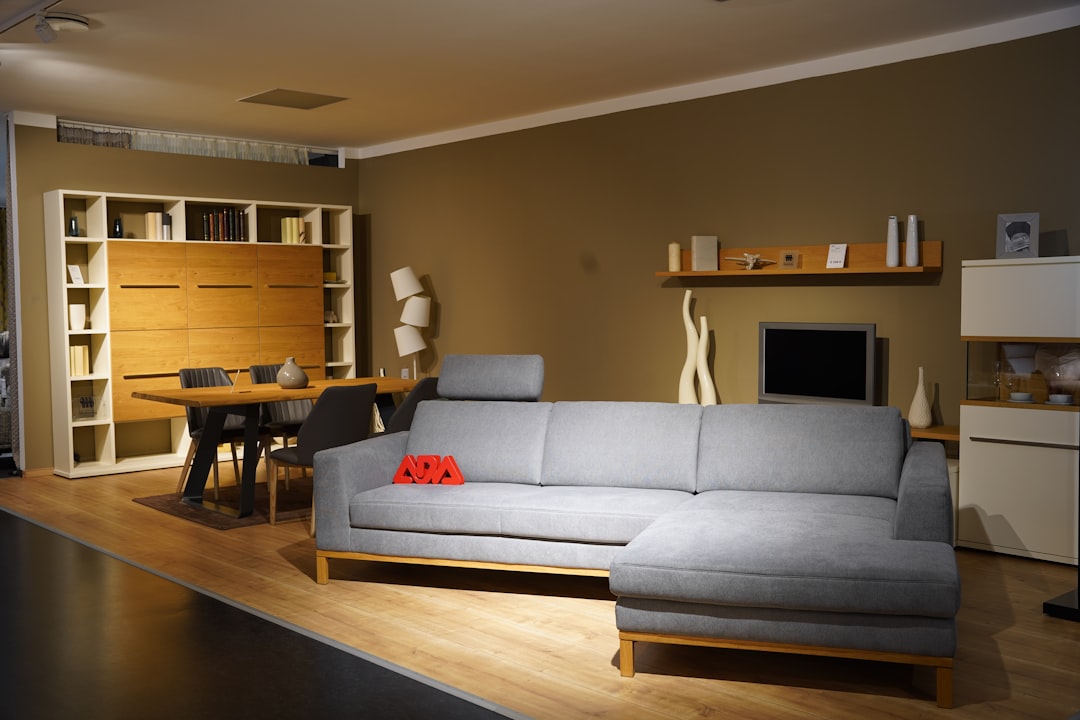
Wow, what a journey! From the rich history of the piano to the nitty-gritty of acoustic vs. digital, and the ins and outs of buying, maintaining, and upgrading your instrument — you’re now armed with all the knowledge you need to make a confident choice.
Here’s the bottom line:
If you crave authenticity, rich resonance, and a lifetime companion, an acoustic piano — be it a majestic grand or a space-saving upright — is your soulmate. Just be ready for the commitment of space, maintenance, and budget. Brands like Yamaha, Steinway & Sons, and Kawai consistently deliver excellence in this realm.
On the flip side, if versatility, portability, and budget-friendliness top your list, a digital piano will be your best friend. Models from Roland, Casio, and Korg offer realistic touch and sound, plus modern features like headphone jacks and recording capabilities. Hybrid pianos like the Kawai NV5 blend the best of both worlds if you want to dabble in both.
Remember: The best piano is the one that inspires you to play every day. So, take your time, test-drive your favorites, and listen to your heart (and your ears). We promise, your perfect piano is out there, waiting to make beautiful music with you.
Ready to take the plunge? Let’s get you shopping! 🎹
Recommended Links 🔗
👉 Shop Acoustic Pianos:
- Yamaha Acoustic Pianos: Amazon | Yamaha Official Website | Sweetwater
- Steinway & Sons: Official Website | Amazon
- Kawai Acoustic Pianos: Amazon | Kawai Official Website
👉 Shop Digital Pianos:
- Roland Digital Pianos: Amazon | Roland Official Website | Musician’s Friend
- Casio Digital Pianos: Amazon | Casio Official Website
- Korg Digital Pianos: Amazon | Korg Official Website
Hybrid Pianos:
- Kawai NV5 Hybrid Piano: Amazon | Kawai Official Website
Books to Deepen Your Piano Knowledge:
- The Piano Book by Larry Fine — Amazon
- How to Play Piano by James Rhodes — Amazon
- Piano Maintenance and Tuning by Stefan Knüpfer — Amazon
FAQ: Your Burning Piano Questions Answered! 🔥

What are the key differences between acoustic and digital pianos that I should consider when making a purchase?
Acoustic pianos produce sound through hammers striking strings, creating rich, organic tones with complex harmonics and natural resonance. They offer authentic touch and dynamic control due to their mechanical action. However, they require regular tuning, are sensitive to humidity and temperature, and need a dedicated space.
Digital pianos use sampled or modeled sounds played through speakers or headphones. They offer portability, volume control, and additional features like recording, multiple instrument voices, and connectivity to devices. Their touch response has improved dramatically with weighted keys and hammer action, but some purists feel they lack the nuanced expressiveness of an acoustic.
In summary: Acoustic pianos excel in authentic sound and feel but demand maintenance and space. Digital pianos offer convenience, affordability, and versatility, making them ideal for beginners, apartment dwellers, or tech-savvy players.
How do I determine my budget for buying a piano and what features can I expect at different price points?
Your budget should balance your musical goals, space, and commitment level. Here’s a rough guide:
| Price Range | Piano Type | Features & Expectations |
|---|---|---|
| Under $1,000 | Entry-level Digital | Basic weighted keys, limited polyphony, minimal features, suitable for beginners. |
| $1,000 – $3,000 | Mid-range Digital | Better sound samples, full 88 keys, improved key action, additional voices and connectivity. |
| $3,000 – $10,000 | Entry Acoustic Upright or High-end Digital | Acoustic uprights with solid construction; digital pianos with premium sound engines and hammer actions. |
| $10,000+ | Grand Acoustic & Hybrids | Superior craftsmanship, rich tonal quality, responsive action, ideal for serious players and performers. |
Pro tip: Factor in additional costs like tuning, moving, and accessories when setting your budget.
What are the most important features to look for when choosing a piano, such as action type, sound quality, and durability?
-
Action Type: Look for fully weighted, hammer-action keys to develop proper technique. Graded hammer action (heavier in the low end, lighter in the high end) mimics acoustic pianos best. Avoid unweighted or semi-weighted keys if you want a realistic feel.
-
Sound Quality: For acoustics, listen for rich, balanced tone with consistent volume across all keys. For digital, seek high-quality piano samples or modeling with natural decay and resonance.
-
Durability: Acoustic pianos should have a solid hardwood soundboard and sturdy frame. Digital pianos should be made from quality materials with reliable electronics.
-
Polyphony (Digital): Minimum 64-note polyphony for beginners; 128+ for advanced players to avoid note dropouts during complex passages.
-
Additional Features: Connectivity (MIDI, USB), headphone jacks, built-in metronomes, and recording capabilities can enhance practice and performance.
Are there any specific brands or models of pianos that are highly recommended for beginners, intermediate, or advanced players?
For Beginners:
- Digital: Roland GO:KEYS, Yamaha P125, Casio Privia PX-160 — affordable, reliable, and beginner-friendly.
- Acoustic: Yamaha U1 (upright), Kawai K-15 — durable and consistent sound, great for learning.
For Intermediate Players:
- Digital: Roland FP-30X, Yamaha P515 — improved key action and sound quality, more features.
- Acoustic: Kawai K-200, Boston Uprights (by Steinway) — richer tone and better touch.
For Advanced Players:
- Acoustic Grand Pianos: Steinway Model M or B, Bösendorfer 160, Yamaha CFX — concert-quality instruments.
- Hybrid: Kawai NV5, Yamaha AvantGrand series — combine authentic touch with digital versatility.
Remember: The best piano is one that fits your needs, space, and budget while inspiring you to play daily.
Reference Links 📚
- Piano Buyer: Piano Buying Guide — The definitive online resource for piano buyers, independent and comprehensive.
- Yamaha Pianos Official Site
- Steinway & Sons Official Site
- Kawai Pianos Official Site
- Roland Digital Pianos
- Casio Digital Pianos
- Korg Digital Pianos
- Liberty Park Music: How to Choose the Right Piano
- Pianote: How to Buy a Piano
Ready to find your perfect piano? Dive into our Piano Brand Guides and Piano Comparison sections for detailed reviews and side-by-side specs. Happy playing! 🎶

